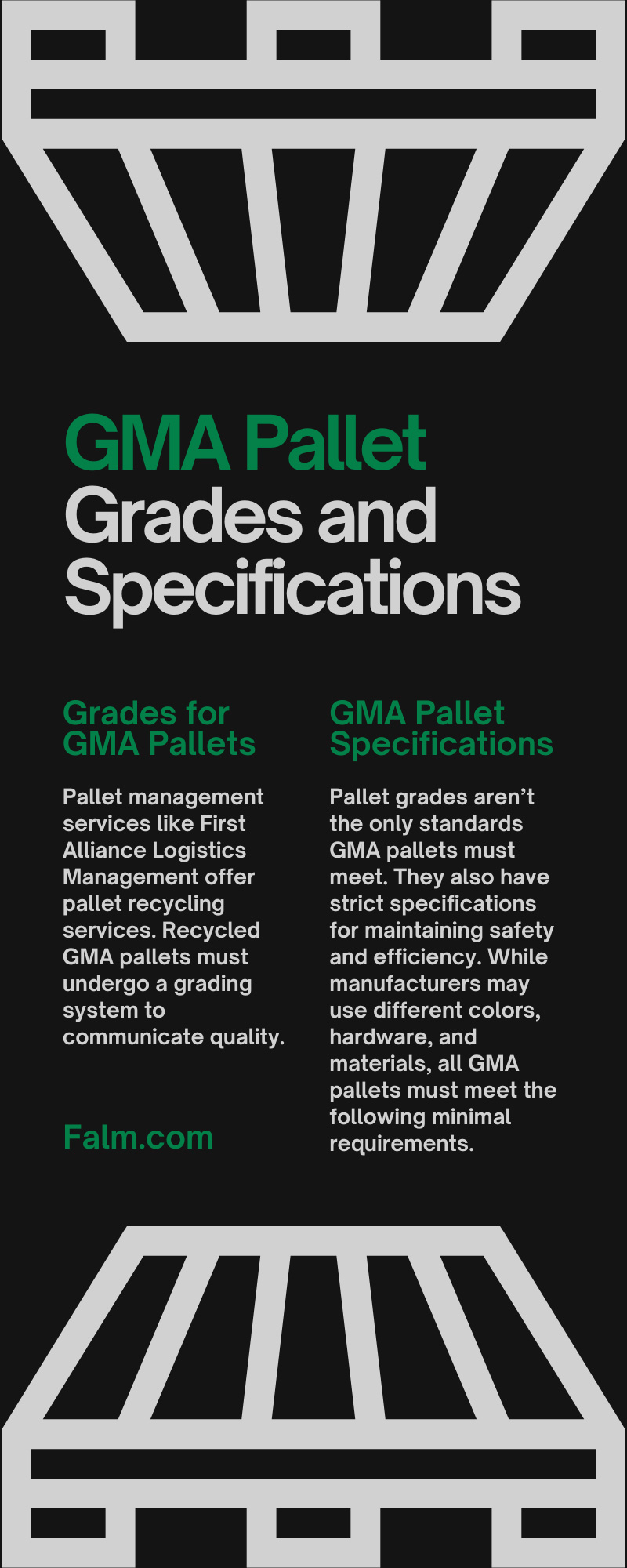GMA pallets are among the most popular pallets on the market. These pallets meet the International Organization for Standardization and Grocery Manufacturers Association guidelines. Businesses in the food and beverage industry can rely on GMA pallets to store and transport goods efficiently.
Not all pallets meet GMA standards. Knowing the particular features and guidelines for GMA pallets will ensure you’re always in compliance. Here’s a guide to GMA pallet grades and specifications to make things simple, courtesy of First Alliance Logistics Management.
What Are GMA Pallets?
GMA pallets are a category of pallets that have specific characteristics. The Grocery Manufacturers Association designed this classification system to make distributing and storing food and beverage items easier. These standards involve grade qualities, sizes, materials, and other essential specifications.
Grocery stores and food-related businesses aren’t the only entities that use GMA pallets. Because of their versatility, GMA pallets are beneficial for a variety of industries. The pharmaceutical, industrial, and government sectors also use these pallets for logistical purposes.
A good pallet vendor will have an ample supply of GMA pallets available to accommodate your needs. Their pallets will meet the necessary standards to help you avoid any costly mistakes and consequences.
Grades for GMA Pallets
Pallet management services like First Alliance Logistics Management offer pallet recycling services. Recycled GMA pallets must undergo a grading system to communicate quality. This guide to GMA pallet grades and specifications will break down each pallet grade to simplify the characteristics.
Grade A Pallets
The highest grade a pallet can receive is an A. These pallets are in exceptional condition. Grade A pallets haven’t gone through any major repairs and have very minimal blemishes.
A-graded pallets have a few subcategories. For example, 1A or 1B pallets feature zero metal hardware. They are ideal for food and beverage shipping and storage because they are strong and contaminant-free.
1R pallets are still in excellent condition. However, they may have metal stringers like plates, nails, and staples after restoration. If regular grade A pallets still meet other GMA specifications, you can still use them in grocery stores and other food-manufacturing operations.
Grade B Pallets
The next grade a recycled GMA pallet can get is a B. Pallets in this category are still eligible for commercial use. However, since they’ve undergone substantial repairs, they don’t look as new as grade A pallets.
Like grade A pallets, B pallets also have subcategories. Premium B pallets have few repairs in relation to pallet size and weight capacities. Most will have a few metal additions to make recycled pallets more durable.
On the other hand, standard B pallets have more repairs and replacements. Still, they’re a reliable and cost-effective choice for manufacturers and warehousing operations. While they may not meet GMA guidelines, other industries can use these pallets as long as they meet ISO standards.
Grade C Pallets
The lowest-quality pallets receive C grades. These pallets aren’t up to GMA standards and don’t return to the market as usable logistics tools. They’ve sustained too much damage and undergone too many repairs to perform their essential functions safely.
Pallets vendors should never sell grade C pallets to their clients. Instead, services like First Alliance Logistics Management use these pallets as scrap materials for other projects as an eco-friendly solution.
Other Important GMA Pallet Specifications
Pallet grades aren’t the only standards GMA pallets must meet. They also have strict specifications for maintaining safety and efficiency. While manufacturers may use different colors, hardware, and materials, all GMA pallets must meet the following minimal requirements.
Size
Size is the most defining characteristic among GMA pallets. Each pallet must measure 48 inches long and 40 inches wide. If you’re questioning whether or not your pallets are GMA, the answer is most likely “yes” if they have these dimensions.
GMA pallets also feature specific top and bottom board designs. Every pallet must have a 5½-inch x 40-inch board on each end on both the top and bottom of the pallet. Five 3½-inch x 40-inch boards make up the top surface, while three 3½-inch x 40-inch boards fill the base.
The 48-inch x 40-inch pallet is the most popular size in the United States. These measurements make for extremely versatile and efficient pallets. By standardizing the size, warehouses, transportation services, and manufacturers can always accommodate shipments.
Weight Capacity
GMA pallets also have a minimum weight capacity; each of these standard pallets must be able to hold at least 2,500 pounds of product. They may withstand more depending on their design and function.
This load requirement only adds to GMA pallet versatility. Food and beverage manufacturers can ship massive amounts of products to clients at once using these pallets. Other industries that utilize them for logistical needs can also streamline their transportation and storage procedures.
Transportability
Finally, GMA pallets must be transportable. They need to be forklift-ready so storage and distribution facilities can handle them with ease. Manufacturers achieve this by including certain accessibility features in every pallet.
For example, GMA pallets must have a four-way forklift entry; this includes two notches on each side for easy access.
Wood vs. Plastic GMA Pallets
Traditionally, manufacturers construct GMA pallets out of hardwood. However, more companies are opting for recycled GMA pallets to reduce their carbon footprint. With the right pallet recycling service, pallets remain durable even after restoration.
Wood pallets are cost-effective and sanitary after going through a treatment process. They are safe to handle, repair, and reuse with proper maintenance.
Even so, some logistic management services also offer plastic GMA pallets. This material alternative is excellent when lumber prices and availability are uncertain. Plastic pallets may have a higher price tag, but they pay for themselves in longevity.
Plastic pallets also have recycling capabilities. Additionally, they’re lighter and easy to clean, which contributes to their efficiency.
Purchase GMA Pallets From First Alliance Logistics Management
This guide to GMA pallet grades and specifications should answer any immediate questions you may have about your pallet supply. For any other inquiries, contact First Alliance Logistics Management directly—our GMA pallets always meet industry standards and have the highest quality grades.
No matter your logistical needs, First Alliance Logistics Management has a solution. We have regional pallet vendors across the country that can handle every part of your pallet management. Whether you’re buying new pallets or choosing a recycled alternative, we guarantee trustworthy products and services.


